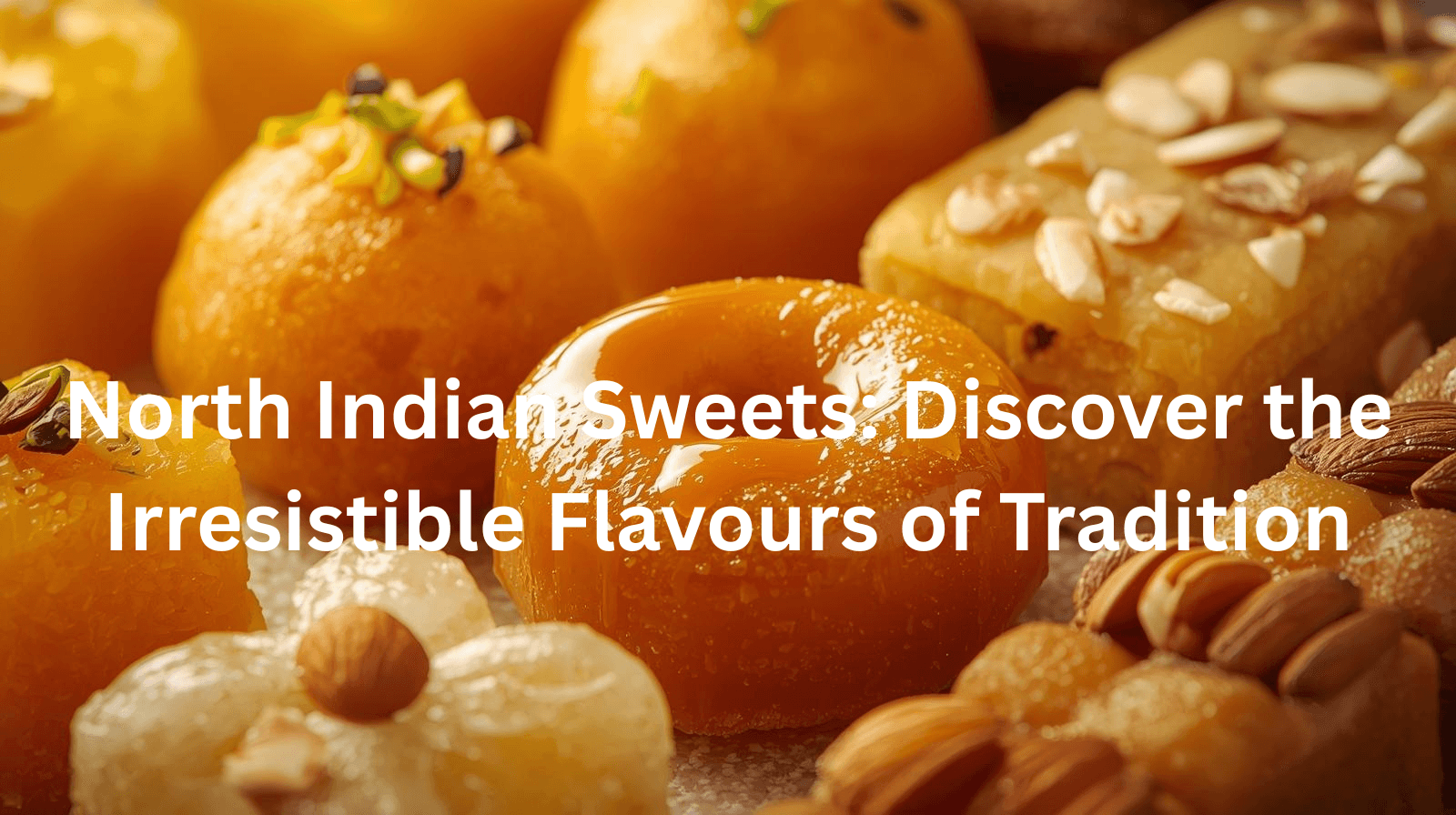
North Indian Sweets: Discover the Irresistible Flavours of Tradition

Gagan Singh
Author
Updated at December 19, 2025
India’s food culture is as diverse as its people—and when it comes to sweets, the northern part of the country is unmatched in variety, richness, and flavour. From royal Mughlai desserts to rustic Punjabi sweets, famous North Indian mithais have become a staple at every celebration.
Whether it’s a wedding, Diwali, Holi, or just a family get-together, regional sweets from North India are loved by generations. Their recipes are often steeped in centuries of tradition and passed down with pride. In this blog, we take you through the most iconic North Indian sweets, their origins, cultural significance, and even where to find them in Singapore.
The Sweet Culture of North India
North India is known for its love of rich, indulgent food, and sweets are no exception. Whether it’s ghee-laden halwa or syrupy gulab jamun, the sweets here reflect the warmth and hospitality of the region.
Sweets are not just for dessert—they are often the centrepiece of festivals, family gatherings, and even temple rituals. In cities like Delhi, Lucknow, Amritsar, and Varanasi, you’ll find sweet shops on every street corner, offering fresh batches of beloved North Indian mithai.
Famous North Indian Mithai You Must Try
Here are some of the most beloved North Indian sweets:
1. Gulab Jamun
These deep-fried balls made from khoya are soaked in rose-flavoured sugar syrup. Soft, syrupy, and melt-in-the-mouth, gulab jamun is a timeless classic.
2. Rasgulla and Rajbhog
Though originally Bengali, rasgulla and its richer cousin, rajbhog, are widely loved across North India too. Made from chhena (paneer), they’re spongy, juicy, and often served chilled.
3. Jalebi
This iconic sweet is made by deep-frying flour batter in swirls and soaking them in saffron-infused syrup. Crispy on the outside and juicy inside, jalebi is a morning favourite in places like Delhi and Jaipur.
4. Barfi
Barfi is a fudge-like sweet made from milk solids and sugar, available in flavours like coconut, pista, badam, and chocolate. It’s a festive must-have.
5. Ladoo
From besan ladoo to boondi and motichoor, these round sweets are essential during weddings and pujas.
6. Kaju Katli
This cashew-based sweet is smooth, diamond-shaped, and often decorated with silver foil. It’s especially popular during Diwali.
7. Soan Papdi
Flaky, light, and sweet, soan papdi is often gifted in festive boxes and loved for its unique texture.
8. Kalakand
A soft milk cake with a grainy texture, kalakand is made by reducing milk and combining it with sugar and cardamom.
9. Peda
Soft, dense, and infused with cardamom, peda is often offered in temples and during religious rituals.
10. Imarti
Similar to jalebi but thicker and made from urad dal, imarti is rich, crunchy, and full of flavour.
For a wider list of sweets you can try in Singapore, check out Akasa's blog on Indian sweet desserts.
Royal Touch: Mughlai Desserts That Defined Luxury
The Mughlai influence brought richness to North Indian cuisine, and its desserts are no less extravagant. Here are some royal treats you must explore:
1. Shahi Tukda
A decadent bread pudding made with ghee-fried bread slices soaked in sugar syrup and topped with thick rabri (sweetened milk), dry fruits, and saffron.
2. Phirni
Served in earthen pots, phirni is made from ground rice, milk, and sugar. It has a creamy texture and is flavoured with rose water or saffron.
3. Kheer
This rice pudding, slow-cooked with milk, sugar, and cardamom, is a sacred and celebratory dessert served across homes and temples.
4. Sheer Khurma
Prepared especially during Eid, this Mughlai vermicelli pudding is rich with dates, nuts, milk, and ghee.
These Mughlai desserts often featured in royal banquets and are still favourites in North Indian fine dining.
Traditional Punjabi Sweets and Their Heritage
Punjabi cuisine is bold, flavourful, and generous—and so are its sweets. Here are some iconic Punjabi sweets:
1. Pinni
Made with wheat flour, ghee, jaggery, and dry fruits, pinni is a winter favourite that keeps you warm and energised.
2. Gajar Ka Halwa
This famous carrot-based dessert is slow-cooked in ghee and milk, and topped with nuts. It's a must-have during Lohri and Diwali.
3. Atta Ladoo
These wheat-based ladoos are rustic and filling, commonly made at home and during religious festivals.
4. Kheer and Rabri
Punjab is known for its full-cream milk dishes like rabri—thickened sweet milk topped with malai.
Punjabis love their food and will often end meals with mithai—even at restaurants. Try it at a North Indian restaurant in Singapore to experience the authenticity.
Regional Sweets in North India: A State-Wise Journey
Uttar Pradesh
- Balushahi: A doughnut-like sweet soaked in sugar syrup.
- Khurchan: A Varanasi delicacy made from thick layers of milk cream.
Rajasthan
- Ghewar: A disc-shaped honeycomb sweet soaked in sugar syrup.
- Mawa Kachori: Deep-fried pastry stuffed with mawa and dry fruits.
Delhi
- Daulat ki Chaat: A rare winter dessert made from milk froth, sugar, and saffron.
- Milk cake: Dense and caramelised, often gifted during weddings.
Punjab
- Panjeri: A nutritious mixture of nuts and grains, used in postpartum diets.
Haryana
- Besan ka puda: A sweet gram flour pancake with sugar and fennel.
Each of these regional sweets from North India reflects the local produce, climate, and culinary heritage.
6. Festivals and Mithai: A Sweet Connection
No North Indian festival is complete without sweets:
- Diwali: Kaju katli, barfi, and ladoos dominate the scene.
- Holi: Gujiya, malpua, and thandai-flavoured sweets are popular.
- Raksha Bandhan: Soan papdi and peda are gifted.
- Lohri: Pinni, gajak, and rewari are shared with family and friends.
- Eid: Sheer khurma and seviyan mark the celebrations.
If you’re planning festive catering, check out Indian vegetarian catering services in Singapore for traditional mithai platters.
How North Indian Sweets Are Made
Most North Indian mithai use a few key ingredients: milk, khoya (reduced milk), ghee, sugar, nuts, and cardamom. The process can be time-consuming, involving hours of stirring, reducing, and layering.
Some common techniques include:
- Boiling and reducing milk (for barfi, kalakand, kheer)
- Deep frying (gulab jamun, imarti, balushahi)
- Soaking in syrup (jalebi, cham cham)
- Layering with nuts and cream (shahi tukda, rabri)
Want to try making them yourself? Look out for traditional mithai recipes in Akasa’s culinary guides.
North Indian Mithai vs South Indian Sweets
While both regions share a love for sweets, there are key differences:
Aspect
North Indian Sweets
South Indian Sweets
Base
Khoya, milk, ghee
Coconut, rice, jaggery
Texture
Rich and dense
Light or chewy
Flavours
Cardamom, saffron, rose
Jaggery, cardamom, ghee
Popular Sweets
Gulab jamun, barfi, ladoo
Mysore Pak, payasam, adhirasam
If you're hosting a dinner and want a sweet mix, consider Indian food catering in Singapore that includes both regional varieties.
Conclusion
From festive ladoos to royal phirni, North Indian sweets are a celebration of tradition, craftsmanship, and cultural richness. Whether you crave Punjabi sweets, Mughlai desserts, or lesser-known regional sweets from North India, there’s a world of flavour waiting to be explored.
Celebrate every occasion with authentic North Indian mithai from Akasa Singapore—crafted with love, delivered with care.
Related Blogs:
Tanjong Pagar bar | Indian vegetarian restaurant Singapore | Lau Pa Sat food | Dinner ideas Singapore | Best butter chicken Singapore | Cheap food in Orchard | Cheap brunch Singapore | Affordable restaurants with a view Singapore | Best restaurants for Valentine's Day | Affordable family restaurants Singapore | Indian sweet dessert | Popular restaurants in Singapore | Health food restaurants | Best Indian buffet Singapore | Best affordable Indian restaurants in Singapore | Best Fine Dining Restaurants in Singapore | Healthy Indian food | North vs South Indian food
Frequently Asked Questions
Gulab jamun, jalebi, rasgulla, kaju katli, and gajar ka halwa are among the most famous North Indian mithai.
Punjabi sweets are often rustic, homemade, and nutritious, while Mughlai desserts are royal, rich, and indulgent with cream, nuts, and saffron.
Yes, you can order from Akasa's Indian sweets delivery service and enjoy authentic mithai at home.
Kaju katli, barfi, gulab jamun, and ladoo are versatile and well-loved during most festivals.
Most are naturally vegetarian, especially those made from milk, sugar, ghee, and flour.
Shahi tukda or phirni are great showstoppers that end a meal on a royal note.
Ghewar, mawa kachori, and balushahi are iconic Rajasthani sweets.
Yes, it’s a traditional Punjabi sweet made during winter and festivals like Lohri and Diwali.
Kaju barfi, ladoo, peda, and gulab jamun are commonly served at weddings and engagements.
Yes! Akasa features affordable restaurants with a view and sweet boxes perfect for parties.
